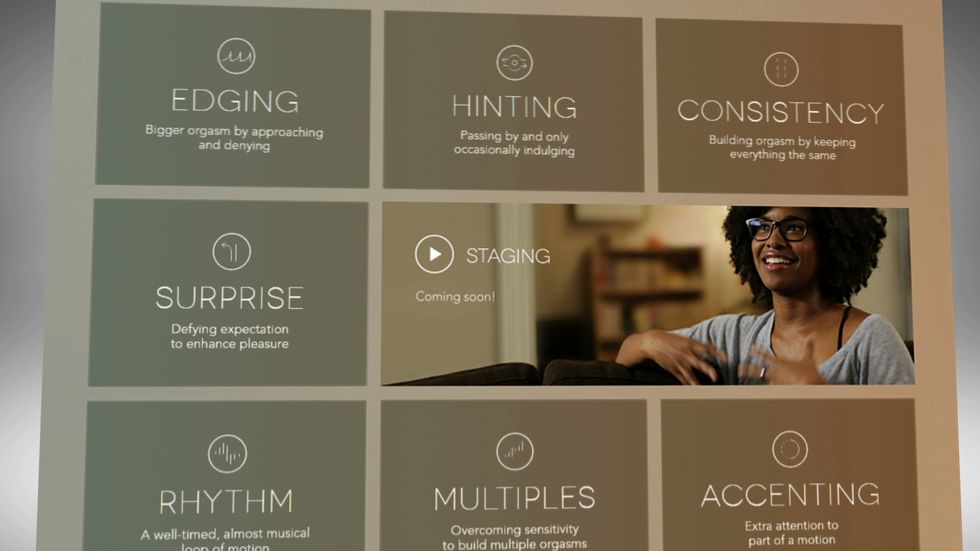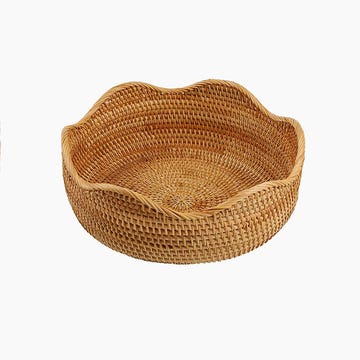Emma Watson's telegenic, sharply accented persona lends an air of erudition to anything she discusses, even if that thing happens to be a web-based, animatronic vulva. From Jennifer Lawrence's lips to god's ears, the same topic might serve as a mere punchline. But hearing Watson tell Gloria Steinem about how much she loves using OMGYes, a female-focused web app with videos, tips, and, yes, an impressively well-engineered digital vulva to help women explore their orgasms, proves the Ivy League ingenue can class up almost anything.
OMGYes is just one of many tech-focused companies competing in the crowded bazaar of marketplace feminism; a digital-first entrant into a long line of business aimed at selling women the secrets of their own bodies. For $59 (currently reduced to $39), customers can purchase Season 1, a set of 50 videos and 11 "touchable video" vulvas made to educate users on 12 orgasm-enhancing topics.
The videos feature a diverse group of women, varying in age, race, and sexual preference, as they discuss masturbation-specific techniques like orbiting, edging, and hinting, as well as general sexual techniques on how to get out of your own head and improve feedback with a partner. Most topics feature multiple videos—as OMGYes uses as an example often, circling the clitoris may feel great to two women, but the exact orbit necessary can vary wildly—and each video follows a basic format: a brief interview with an individual woman, before two to three minutes of watching closely (at times, very closely) as she demonstrates the technique.
The company touts the research behind its products; 2,000 women were interviewed on sexual pleasure and orgasm, and the brand has worked to align itself with famous sexuality think tank The Kinsey Institute, rather than just pop psychology. (The Kinsey Institute has been supportive of OMGYes' work, but has stated they are not formally involved with the company.) But 2,000 interviews don't necessarily equal a peer-reviewed study, and masturbation, like most things sexual, is highly personal. Can 2,000 viewpoints distilled down to 50 video clips actually demystify masturbation? Or is it just another statistic, sold to a captive audience that fears they don't know their own bodies as well as they should?
Contrary to all my expectations, the videos are excellent. The interviews are sometimes funny and always conspiratorial (as one woman discusses how she learned about edging, a technique of gentle orgasm denial to build to a stronger climax, she reflects fondly on the partner who had never been with a woman before who taught her the process), while the lighting and staging is more evocative of a well-stocked WeWork office space than anything resembling a porno film. The nudity becomes routine quickly, and there's something immensely comforting in seeing a series of breasts that flop to the sides of women's bodies as they recline backwards, even if the parade of vulvas all are more groomed than my own certainly has ever been. (I assume this is for demonstrative purposes, more than any sort of pubic shame.)
The touchable vulva takes some work getting used to; for as straightforward and warm as the live videos are, the digi-vag is scored by a breathy, robotic voice that moans far too throatily for my tentative clicks. I've never been at the apex of a woman's legs before—the perspective the digital vulva takes on, in stunningly realistic size—and no matter how often a helpful arrow shows me how to layer my touch on the hood of her clitoris in a circular pattern, I can feel and hear the sexy robot growing increasingly impatient as her throaty moans are reduced to exasperated sighs and passive-aggressive asks of "Are you still there?" Perhaps the most realistic part of OMGYes is the freeing revelation that even digital vagina-owners can be difficult to please.
I'd be lying if I said I didn't learn something. In a crowded ecosystem of products sold precisely to prey on a woman's worst fears—in this case, being behind the curve of the clitoral orbit—OMGYes manages to strike a tone that's educational without being overly verbose, and wholly accessible yet never twee. But one weekend and countless orgasms later, I'm still left wondering: where is the line between education and discovery?
There's no denying the orgasm gap: per a study conducted by the National Survey of Sexual Health and Behavior that interviewed 1,931 Americans between the ages of 18 and 59, 91% of males say they climaxed in their last sexual encounter, while only 64% of women were able to say the same. To then criticize an educational program created to address said orgasm gap and reduce the opacity around the world of female pleasure feels verboten. But so does watching five hours of videos that map out the topography of a number of vaginas in such stunningly rendered detail that I can tell by the density of bumps on a mound how long ago a participant's last wax must have been.
The information is fantastic, but it's also a paralytic. While my usual masturbatory porn diet of two sexual positions and a rimjob in under eight minutes could use some oomph, the increased focus on hinting versus accenting and rhythmic orbits all made the process of masturbating largely performative. It became a set of academic techniques to practice and hone over time to inure me from the idea that an orgasm was unattainable, rather than actual, practical tips.
To hear Watson describe OMGYes, the overabundance of information I was struggling with seems even more immaterial; as a UN Goodwill Ambassador who has championed worldwide inclusive feminism, Watson advertises the product as the great democratizer in sexual education across cultural boundaries. Yet the videos, currently only in season one, do little to address that, directly or indirectly. Though there is a diversity of race, age, and sexuality, that softly lit set (decorated in this decade's minimalistic, ceramic-tchotchke, succulent-heavy aesthetic) projects just one representation of class and country: upwardly mobile American women.
But more than aesthetics, OMGYes appears to be made for people who are already on board with what it's selling. Though the company has mentioned that future seasons will explore other topics, such as penetrative stimulation (season one focuses solely on the external), outside of a chapter on how to better communicate with a partner, the bulk of the OMGYes curriculum is focused on the mechanical aspects of reaching climax. Little attention is paid to the fact that much of masturbation is mental, and none to the wide variety of roadblocks that are keeping that orgasm gap open. The communication chapter is couples-focused, and sample scripts all operate from the perspective of already being in a sex-positive relationship.
It takes three to four hours to wind through the OMGYes videos, plus time spent practicing technique; a luxury that can elude many who may have the most to gain, but can't afford to carve out that time. No discussion is found around addressing cultural values or personal apprehensions; no mention is even made, in fact, of the very women Watson seemingly hoped to liberate in climax, those who don't know the joys of masturbation or orgasm. Education may be a goal for OMGYes, but in its current iteration, accessibility seems to be an afterthought.
Perhaps the bigger issue for all these products, intended to unlock the secrets of ourselves, is what they seek to solve. Is a problem still a problem if you don't think it's a problem? There is undeniable agency in education—an agency even I felt as I noted tips to save for use myself—but not when it teaches you to put your faith in a product over your own body. At 61 videos on over 12 topics, it can seem almost enough to ruminate through an indirect study of other people's vaginas, rather than finding the answer organically over time, on a journey of discovery within yourself. This category of wellness-focused tech—our sleep sensors, and mood trackers, and spit-and-send DNA kits—is selling us what, exactly? It offers a solution, sure, but to which issue: the accessibility of information, or the larger, specious fear that no matter the topic, when it comes to our own bodies, we may never be able to know it all?














